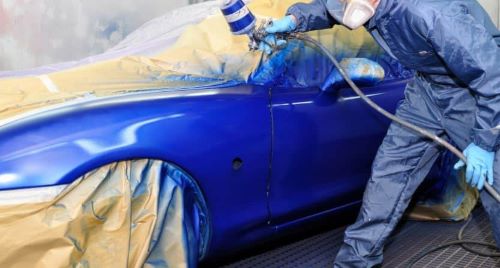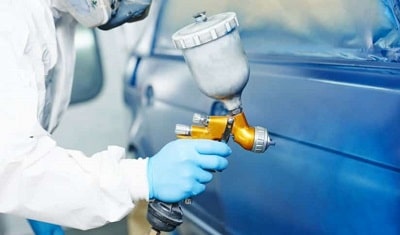 Restore your body paint, as it should
Restore your body paint, as it should
This article discusses tips and advice for the general public who need not have the theoretical knowledge of the complex and extensive painting techniques that professional painters are expected to master.
We will detail here the famous rules of the art that govern the fields of industrial and automotive painting. The rules of the art of painting are the fundamental recommendations, applicable in almost all stages and all types of painting. They are a bit like the 10 commandments of the painter.
When you go to bodywork and paint school, you learn how to repair bodywork, from sheet metal to repairing the primer coats, paint and varnish. We also learn the treatment and polishing techniques of an automotive paint without repair.
It is perfectly possible for a person who has not studied for two years in a school, to carry out quality work on their own, perfectly successful and lasting, thanks to a scrupulous realization of actions and stages.
A summary of the references to these basic recommendations can be found in all the technical data sheets for industrial paints for bodywork paints: when you understand and apply these rules, you can save yourself a lot of work and "pains".
Often, beginners in painting, wanting to save time by saving themselves the careful and laborious stages of the preparation of the supports, obtain reactions and defects of painting, which often oblige them to to start all over. Beyond the expense of products, the time saved on adhering to surface prep rules pales in comparison to the time it takes to re-sand everything and start over.
How to apply body paint in the rules of the Art ?
The techniques relating to body painting require above all maximum care, patience and a lot of meticulousness.
Industrial painters or even decoration painters recognize that it is during the preliminary preparation stage before painting that a large part of the success of the work is at stake.
Just as the bases of a building are the foundations of a solid and durable edifice, so are the bases of the paint, which will guarantee, if done well, a painting guaranteed in terms of good held over time.
The rules of the art of painting are as follows :
“Sound and prepared” :
Paint or varnish should always be applied to a sound and prepared surface. The term "sound" refers to a set of very important properties and represents the most important rule in painting techniques.
By the term support, we mean the material where the paint will be applied: this can be an old background*, paint or raw material.
In any case, it must be perfectly sound in order to receive the paint. That is to say that it must be checked, to see if the support has good cohesion, if it is solid, if it does not contain rust, in which case it must be coated with a putty, the rust must be scraped and sanded and an anti-corrosion treatment must be done.
“Sanded” :
According to the rules of the art, the support must be sanded. Most paintings, to hang on the support, whatever it is, need it to be sanded. It is not a question of taking any abrasive grain to carry out the sanding. You must refer to the technical sheet and respect the sanding grain to the letter, which must be neither too fine nor too coarse.
"Degreased" :
If the surface you are going to paint has "contaminants", the paint will not be able to stick to it, or it will not be able to spread it properly, or even it will suffer appearance defects or reactions. The surface should therefore preferably be degreased.
“Dry” :
The support must be dry according to the rules of the art of painting. You should not apply a paint, either a Hydro paint, and even less a solvent-based paint, on a background that contains water or humidity.
"Dust-free" :
The support must be perfectly dusted, in order to prevent the dust from being covered by the paint and creating visible defects.
 The term background or support
The term background or support
We find this series of terms constantly in the technical data sheets and the recommendations of professional paints: the support must be prepared according to the rules of the art, the bottom must be sound, dry, sanded, dusted and degreased.
The background or support designates any type of surface or material, on which the paint is to be applied.
In order to better understand, here are some examples of bases, encountered in the field of automotive paint :
• an old bodywork clearcoat (50% of cases)
• A primer
• a raw material such as sheet metal
There is a very long list of possible supports and backgrounds, for which the rules of the art of painting strictly apply.
A prepared medium
In addition to the term "sound", it is specified that the support must be "prepared". This is also a term not to be taken lightly because it is a fundamental recommendation.
Depending on the nature of the "background", it may be necessary to apply a specific primer. We have talked about this many times in our technical sheets. Sometimes it is necessary and imperative to apply a primer, while in some cases it is not necessary or useful to apply a primer.
If the support is not properly prepared according to the rules of the art, it may result in the development of rust or the peeling of the paint. These are only exhaustive examples as there is a significant list of faults.
Degrease the bottom
Often, painting beginners tend to degrease too zealously.
It must be understood that the degreaser is a particular solvent : It is the only solvent which manages to melt glues and silicones (It is useless to try to remove glue with bodywork solvents, because it does not work), and at the same time it is a solvent that does not melt paints.
However, the degreasing technique should not be abused : it should generally be done on surfaces that have been touched or handled : this is the case for sanded primers or bases before clearcoat.
In general, we do not advise the painter to degrease a surface that has been freshly sanded. She's supposed to be clean. The degreaser should not be abused as it itself can be the cause of defects and reactions.



















































































